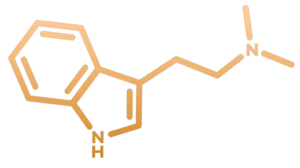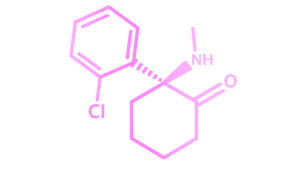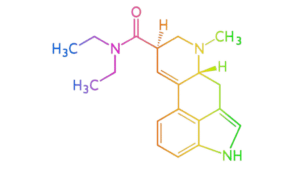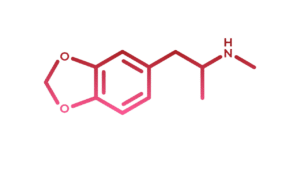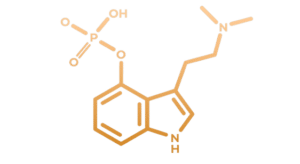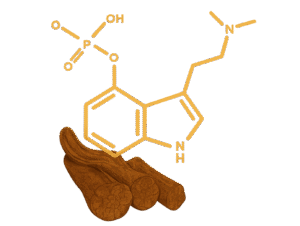What is psilocybin?
Psilocybin is an increasingly well-known psychedelic. It gets its name from the mushrooms it is found in from the genus psilocybe. Its molecular structural formula is C12H17N2O4P and this substance is also known as O-phosphoryl-4-hydroxy-N,N-dimethyltryptamine or indocybin. Psilocybin is found in varying amounts in the mushrooms (magic mushrooms) found on all continents except Antarctica. Many people know psilocybin for its psychedelic and hallucinogenic effects
The metabolism of psilocybin
When psilocybin enters the body, it is first converted into psilocin by dephosphorylation of the phosphate group present. The dephosphorylation of psilocybin is a chemical process in which the phosphate group is removed from the psilocybin molecule. Psilocybin itself is the most well-known alkaloid found in magic mushrooms and magic truffles. The process of dephosphorylation can occur under certain conditions.
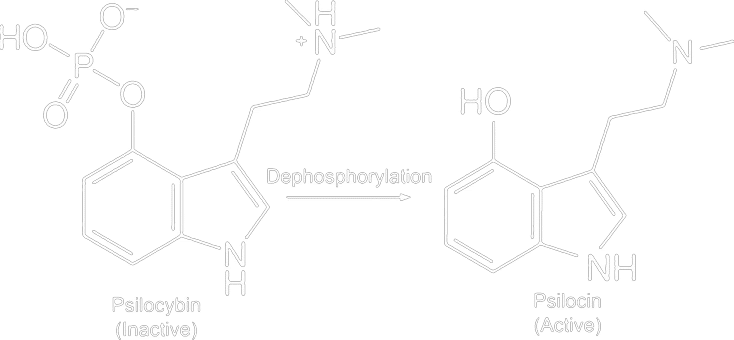
The main way in which dephosphorylation occurs is by the enzyme phosphatase. Phosphatase is a naturally occurring enzyme of the human body and is produced in the liver. This enzyme can hydrolyze the phosphate group, converting psilocybin into psilocin, the active psychoactive ingredient. As soon as psilocybin is absorbed through the intestines, it will first be converted by the liver via the portal vein.
Acidic environments such as the human body and especially the stomach can also cause psilocybin to be converted to psilocin.
The activity of psilocybin and psilocin
If psilocybin were not converted to psilocin, then psilocybin would hardly be psychoactive. For example, psilocin is very active on the 5-HT2B receptor with an inhibitory constant of 4.6 Ki (the lower the constant, the more binding/activity) and psilocybin has a value of 98.7 Ki. Psilocybin is also virtually inactive on the important 5-HT2A receptor and also not on the 5-HT1A receptors. Psilocin does have an effect on the 2A and 1A receptors. The affinity and ability to bind with these receptors is important when it comes to the psychoactive effects of these substances. If we rank the strength of psilocin on the serotonin receptors, the highest is 5-HT2A, then 5-HT2B and then 5-HT1A.
What does psilocin do on these 5-HT receptors?
5-HT1A
Psilocin is therefore a partial agonist of the 5-HT1A receptor, which means that it is able to bind to and partially activate this receptor. Activation of this receptor can produce anxiolytic (anxiety-reducing) and antidepressant effects. The 5HT1A receptor is also involved in regulating autonomic functions such as heart rate, body temperature and endocrine functions.
However, high stimulation can also cause side effects, including nausea and dizziness, which are common during use.
5-HT2A
High stimulation of the 5-HT2A receptor is associated with psychedelic experiences, including visual or auditory hallucinations, a heightened sense of consciousness and an altered sense of time.
For the time being, the 5-HT2A receptor is seen as the most important when it comes to psychedelic effects. Stimulation of this receptor is also associated with increased BDNF concentrations and thus increased neuroplasticity.
5-HT2B
The 5-HT2B receptor plays a role in the regulation of blood pressure and heart rate. One of the best known functions of the 5-HT2B receptor is its involvement in the growth and development of heart valves during embryonic development.
Psilocin's affinity for the 5-HT2B receptor is likely lower than for the 5-HT2A receptor, meaning that its psychedelic effects are mainly mediated through the 5-HT2A receptor.
The subjective experience
The experience of someone taking psilocybin can vary greatly between individuals. The effects depend on several factors with the main reasons being the dose, the environment, the person's state of mind and individual sensitivity to psychedelics. The most common effects and experiences people can relate after a psilocybin trip are the following:
-
Altered perception: Psilocybin is known for causing altered perception of the world around you. Colours may appear more intense and objects may appear distorted or moving.
-
Visual hallucinations: Users may experience visual hallucinations such as patterns moving across surfaces, geometric shapes and distorted images.
-
Altered perception of time: Time may feel different than normal, with the feeling that it is slowing down or standing still.
-
Increased awareness and introspection: People often report a heightened awareness of their own thoughts and emotions. This can lead to deep introspection and self-reflection.
-
Emotional experiences: Psilocybin can induce intense emotional experiences ranging from ecstatic joy to deep introspection and sometimes fear.
-
Spiritual or mystical experiences: Some people report spiritual or mystical experiences during a trip, with feelings of oneness with the universe or transcendence.
-
Euphoria or anxiety: The experience can vary between euphoric feelings and anxiety, depending on the circumstances and the user's mental state.
Ego death
Users who take a lot of psilocybin sometimes talk about an ego death. Ego death mainly has to do with diminishing sense of self. The effects described in the video are the effects that people can have on a high dose of psilocybin.
It is also possible to experience an ego death without using psychedelic substances, such as deep meditation/breathwork or anything else that can bring you into the flow. There are also many similarities with a near-death experience.
Psilocybin and science
Over the last two decades, psilocybin has attracted interest as a potential therapeutic agent for the treatment of various mental health conditions such as depression, anxiety and addiction.
Studies have shown that psilocybin can cause long-term positive changes in mood and behaviour. Scientific researchers are now conducting many clinical trials to investigate how psilocybin can be used in more and more areas. Especially for depression, psilocybin seems to work very well.
Several studies are currently underway and psilocybin is being tested to see if it can provide relief for multiple symptoms. Herewith an overview of topics.
- Alcoholism (AUD, alcohol use disorder)
- Smoking addiction
- Opioid addiction
- Major depression (depressive disorder Major)
- Therapy resistant depression
- Anxiety complaints
- Obsessive-Compulsive Disorder (OCD)
- Body Dysmorphic Disorders (BDD)
- Anorexia
- Alzheimer's
- Parkinson's
- Migraine
- Cluster headache
Psilocybin therapy in the Netherlands
Psilocybin therapy is an experimental psychedelic treatment that is not currently recognized as a formal medical treatment. This means that patients interested in this treatment will have to cover their own costs, as insurers do not currently provide coverage for this therapy. Although the effectiveness of this treatment has been demonstrated for a number of mental conditions, more research is needed before this therapy is widely accepted as a legitimate form of treatment.
Dutch law does allow room for psilocybin sessions that are done with legal magic truffles that also contain psilocybin. The psilocybin sessions we offer are in fact truffle sessions. Read more about our psilocybin therapy via the button.
FAQ psilocybin
Below we answer the most frequently asked questions about psilocybin and whether it is legal to buy and how psilocybin therapy works. Is your answer not listed? Feel free to ask your question via the contact form or via the forum via the buttons below.
What does psilocybin do to you?
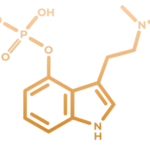
Psilocybin is a substance found in magic mushrooms and is almost not psychoactive. Psilocybin only becomes psychoactive after conversion to psilocin.
Psilocybin, after conversion to psilocin, has several effects on the user, including hallucinations, changes in perception, increased sensitivity to sensory stimuli, and changes in the sense of time and space. It can also lead to altered emotions and mood, introspection and spiritual experiences.
The effects of psilocybin vary depending on dosage, individual sensitivity and environmental factors. Using psilocybin can also pose risks, such as confusion, anxiety or panic attacks, and it is therefore essential to exercise caution and consider the possible consequences.
How do I get psilocybin?
In the Netherlands you can only buy psilocybin by buying magic truffles. The magic truffles contain the substances psilocybin and psilocin, but are not illegal in this form. By eating the truffles you effectively ingest psilocybin.
What are psilocybin drops?
Psilocybin drops are liquid extracts that contain psilocybin. The origins of these droplets are unknown. These drops are often used as an alternative way to take psilocybin because they are easy to dose and take. The effect of psilocybin drops is comparable to that of eating psilocybin-containing mushrooms. It can lead to altered perceptions, hallucinations and an altered state of consciousness. However, the use of psilocybin drops is illegal in the Netherlands.
Is psilocybin banned?
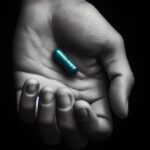
Yes, psilocybin is banned in the Netherlands. It is on the list of prohibited substances according to the Opium Act. Possessing, selling, growing or trading in psilocybin-containing mushrooms is a punishable offense.
Can I microdose psilocybin?
Yes, you can psilocybin microdosing. Microdosing refers to taking very small amounts of a substance, such as psilocybin, to experience subtle effects without having a full psychedelic experience. It is often done to improve mood, increase creativity and improve concentration.
Is psilocybin therapy already possible?
Yes, psilocybin therapy is already a medical treatment in Australia. In the Netherlands, psilocybin therapy is not yet considered a medical treatment, but is used during certain clinical trials for the treatment of certain mental disorders, such as depression, anxiety disorders and post-traumatic stress disorder (PTSD). The psilocybin therapy, which is done with psilocybin-containing truffles, is legal, but is not a medical treatment.
Do health insurers reimburse psilocybin treatment?
No, in the Netherlands health insurers do not reimburse psilocybin treatment because it is not yet recognized as a medical treatment. For the time being, psilocybin sessions are seen as coaching under the influence of a stimulant.
How does a guided psilocybin trip work?
The exact course of a guided psilocybin session can vary depending on the counselor/therapist and the specific needs of the person. In general, the session takes place in a quiet and comfortable environment such as our location or in your own home. The therapist will inform you prior to the session about what to expect and answer any questions you may have.
During the session you take a dose of psilocybin (in the form of magic truffles). The therapist will guide you through the effect of the psilocybin, supporting you in exploring your thoughts, emotions and experiences. They may conduct conversations, offer guided meditations, or use other techniques to help you gain insights and process any problems you may have.
The purpose of a guided trip session is to increase therapeutic effects, such as increasing self-awareness, exploring repressed emotions, reducing anxiety or depression, and promoting personal growth and well-being. A therapist or supervisor also ensures physical safety and helps with preparation and integration.
